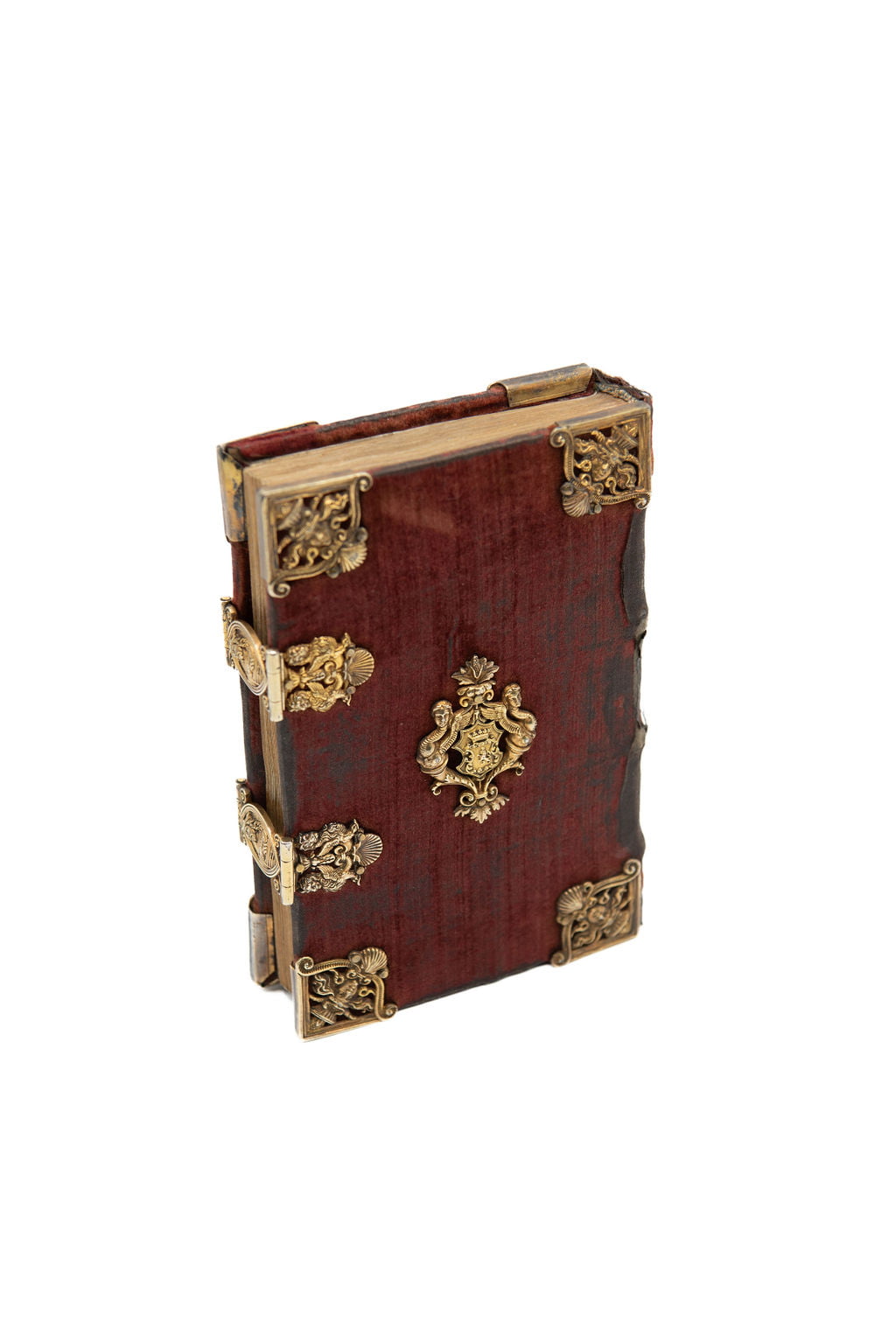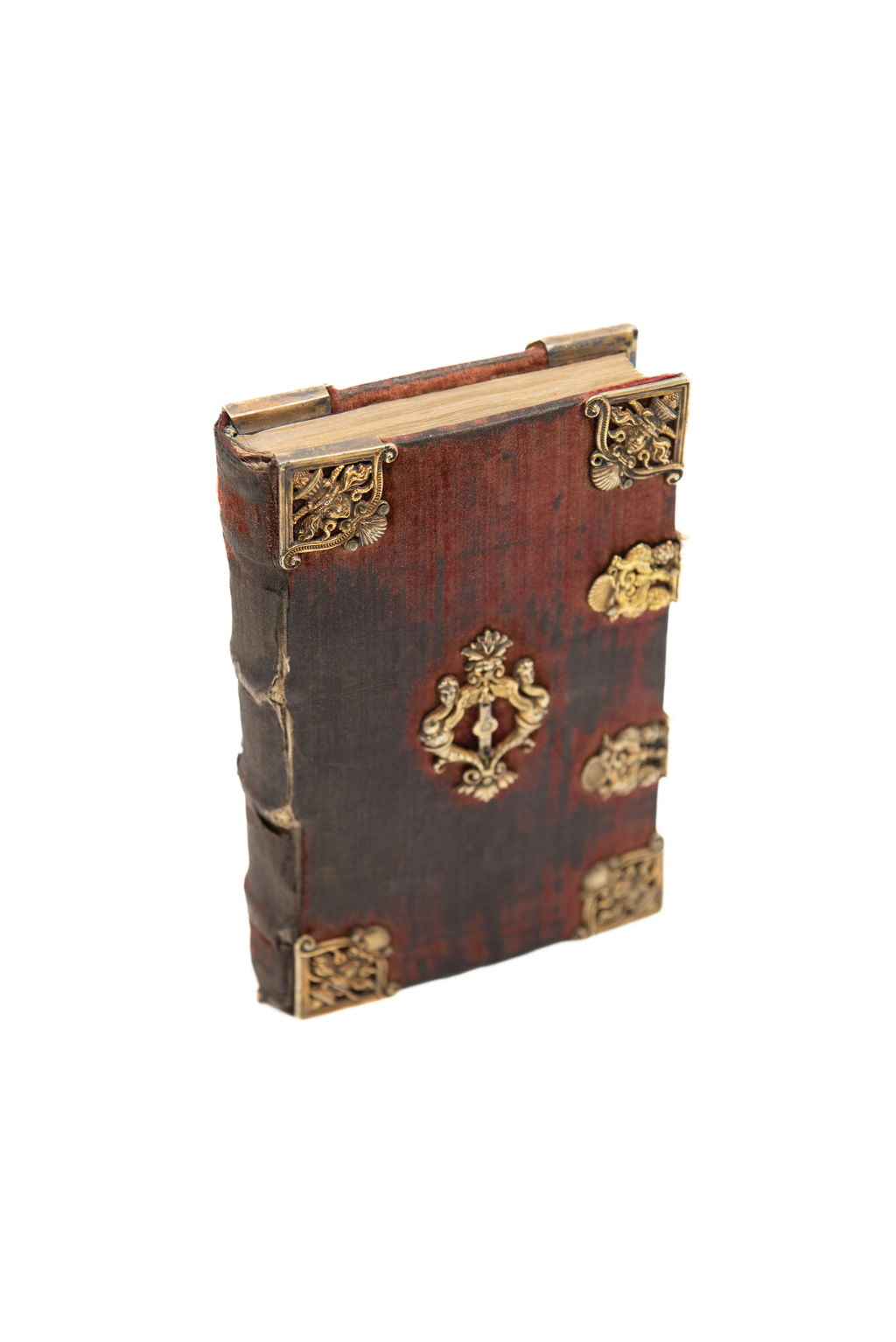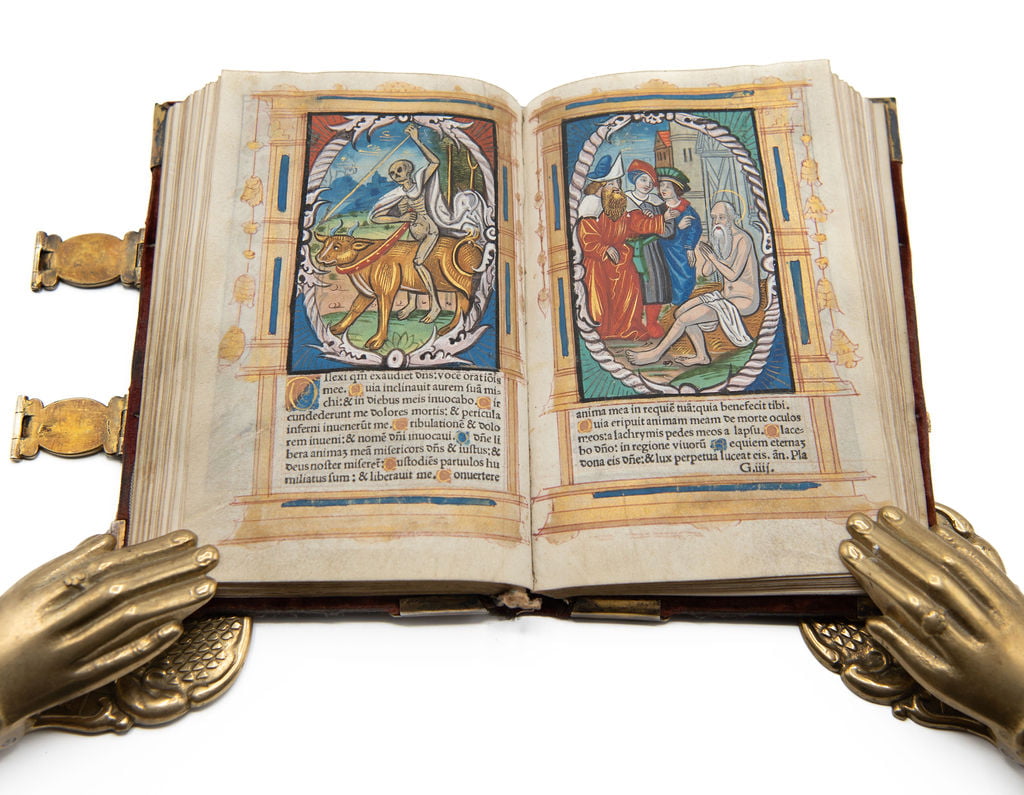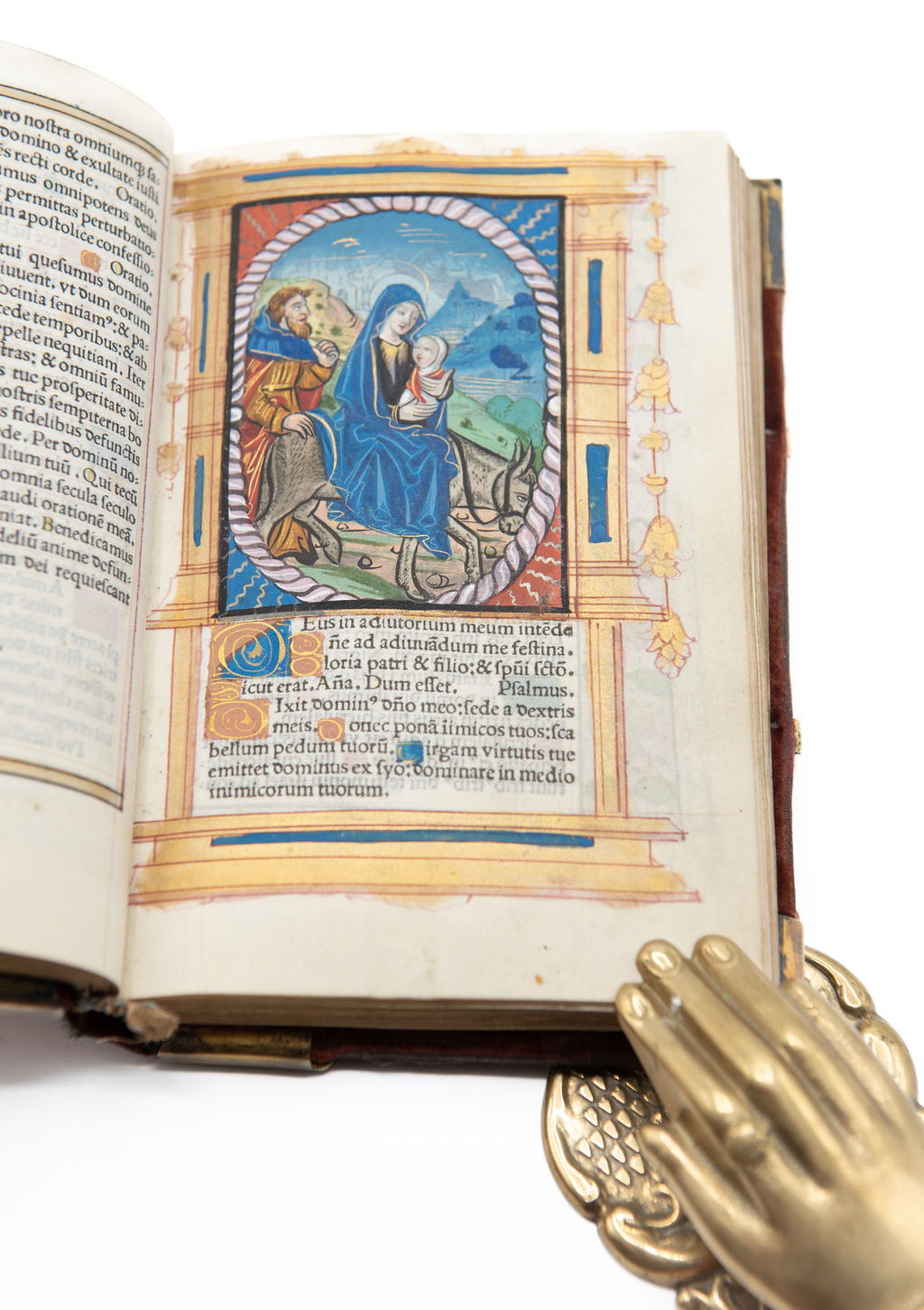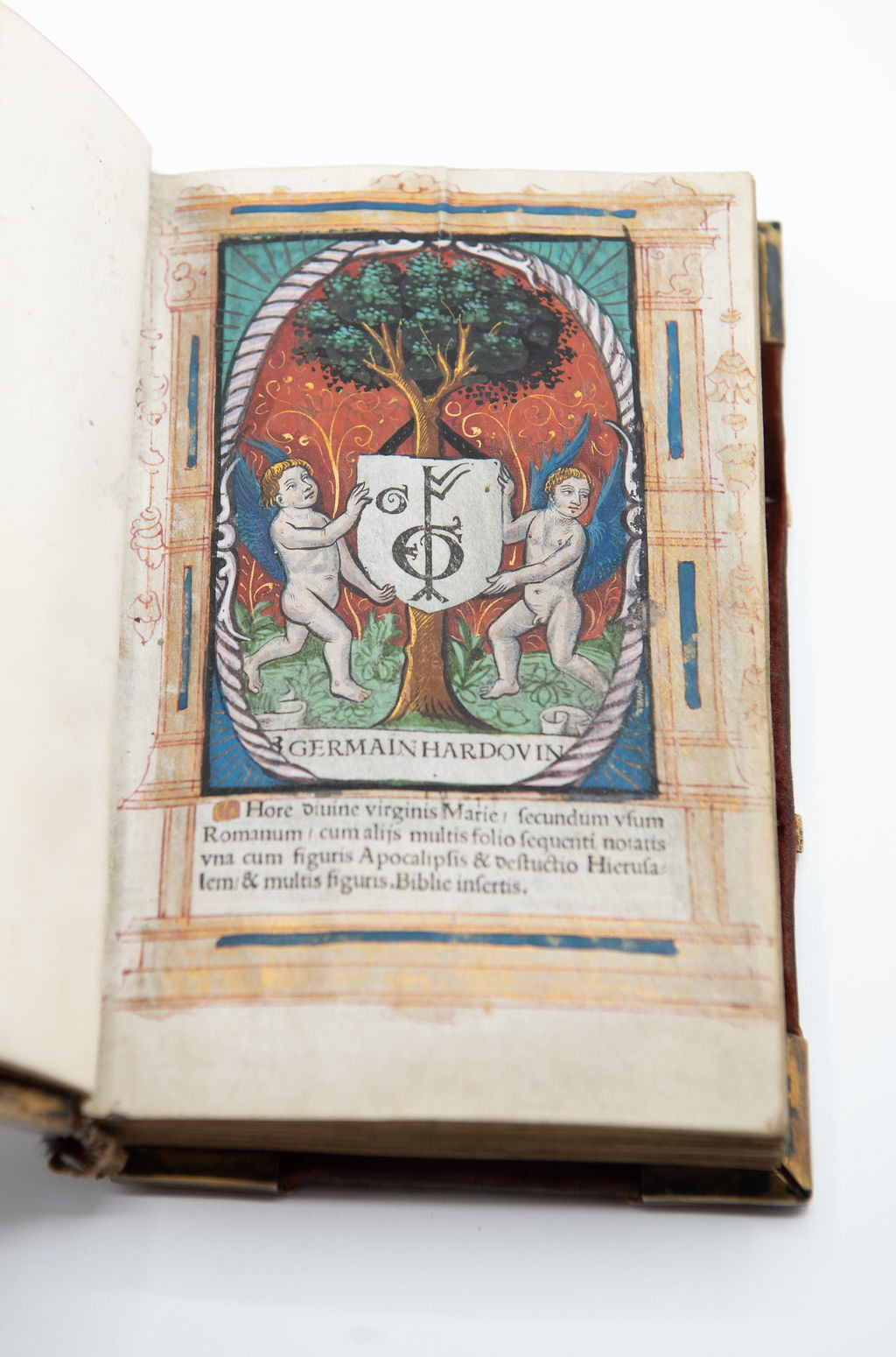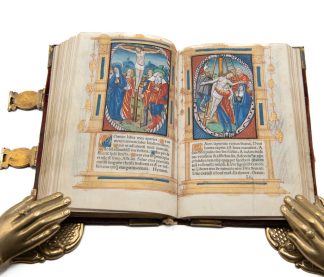BOOK OF HOURS
A PRINCE-BISHOP’S COPY
Use of Rome, in Latin. Hore divine virginis Marie secundum usum Romanum
Paris, Germain Hardouyn, 1533 (Kalender: 1520-32)£38,750.00
PRINTED ON VELLUM 8vo. 96 unnumbered leaves, A-L8, a8. 31 lines. Roman Letter. Six full page and fifteen large half page metalcuts, all freely illuminated in gold and colours by a contemporary hand with gold painted architectural borders ruled in red, to each large cut, twelve small freely painted metalcuts in text. Metalcut skeleton with four small cuts all freely painted on verso of title, borders to each page ruled in red and black, painted with gold, with large freely painted floral and vine outer borders on liquid gold grounds, entirely rubricated with liquid-gold initials and line-filler on alternate red and blue grounds. A1r, title with Hardouin device, A1v Skeleton with four small cuts and with text in French, A2r table, A2v almanac for 1520-1532, A3-A5r calendar, A6r-A8r Gospel sequence (two full page cuts), A8v-B4r Passion according to St. John, B4v-F4r Hours of the Virgin (nine large cuts), F4v-G3r, Seven Penitential Psalms (two large cuts, King David and Bathsheba), G3r-I1r Office of the Dead (two large cuts, one of Job on his dungheap), I1v-I4v Hours of the Cross and of the Holy Ghost (three large cuts of Crucifixion etc), I5r- K1v Office of the Immaculate Conception and Beata Maria (one large cut, one text cut), K2r-L8v, Suffrages, prayers to the saints (one large cut, and eleven text cuts), a1r-a8v ‘hore ad laudem divi Hieronymi’ by Giovanni Andrea Bishop of Aleria in Latin and in French. Inscription on pastedown “16+28 Benefac Dne bonis et rectis corde Georgius Friderius Arcbicps Mogts” (the gift of Georg Friedrich von Grieffenklau zu Vollards, Archbishop-Elector of Mainz dated 1628). A fine copy, with the painting and gold absolutely fresh and clean, in stunning early C17th velvet over wooden boards, 8 large grotesque gilt metal cornerpieces of a medusa head with scallop below, two finely worked gilt metal clasps with a portrait of a warrior within oval, four gilt metal catches with a pair of griffins with open scallop beneath, arms at centre within ornate grotesque border of winged figures out of cornucopia (shield missing from upper cover). velvet worn on spine and edges, all edges gilt.
Extremely rare, finely printed and beautifully illuminated book of hours, finely printed on good quality vellum with the cuts beautifully illuminated in gold and colour in a rectangular format. The illuminator has not simply coloured the cuts beneath but has freely painted over them or extended the painting of the figures beyond the original borders. Books of hours were used by individuals at home rather than in church. A calendar was attached to the front so that memorial days of the saints could be identified. They were typically structured around the hourly prayers observed in monasteries and Catholics would recite the appropriate liturgy eight times a day. These books served as symbols of status and were often luxurious items, gifts given on important occasions.“An important point to notice in connection with the illustrations of French ‘Books of Hours’ at this time is that they are nearly all inspired by German artists and nearly all copied from illuminated MSS.” Joseph Cundall. ‘A Brief History of Wood engraving.’
The Hardouin’s workshop dominated the market of printed books of hours, in Paris between 1510 and 1550. Gillet Hardouin worked primarily as a printer, between 1500 and 1542, and German Hardouin was registered in the Guild of Illuminators. They were the only editors capable of both printing and illumination without commissioning other professionals. They often used fine, densely ornamented metal cut borders, however they had gone out of fashion by the time this vol was produced, which gives this volume a much cleaner and clearer style. Here borders have been added but have been freely painted in the margins over gilt grounds. The quality of their work is remarkable. It seems that they produced books of hours in various formats, from ordinary copies printed on paper to those printed on vellum with woodcuts and the most luxurious where the entire book was illuminated over the original cuts, most often on commission for a specific client. The addition in the final quire of the Hours of St Jerome by Giovanni Andrea Bishop of Aleria is interesting and unusual. Lacombe points out that it is difficult to understand why this volume, apparently printed in 1533, contains a calendar dating from 1520-32, though does not suggest that it was printed at an earlier date.
Georg Friedrich von Greiffenklau zu Vollrads was born in Schloss Vollrads on 8 September 1573. He was educated at the Collegium Germanicum in Rome. In 1616, the cathedral chapter of Worms Cathedral elected him to be Bishop of Worms and then elected him to be Archbishop of Mainz in 1626. As Archchancellor of the Holy Roman Empire, Georg Friedrich authored the Edict of Restitution in 1627. The Archbishop of Mainz was an influential ecclesiastic and secular prince in the Holy Roman Empire and was the primas Germaniae, the substitute for the Pope north of the Alps. Aside from Rome, the See of Mainz is the only other see referred to as a “Holy See”. The beautiful velvet ‘treasure’ binding could well have been made for him as befitting someone of his status in the Church. A very beautiful and luxurious book of hours, exceptionally well preserved.
Lacombe 396. Bohatta 1162. Van Praet I, 113, 136. Brunet, Heures 254. Moreau IV, 713.In stock



